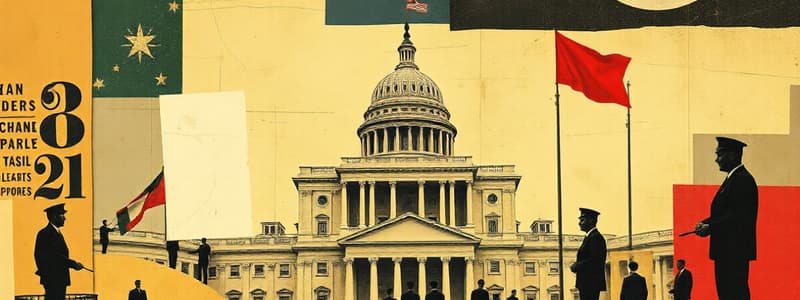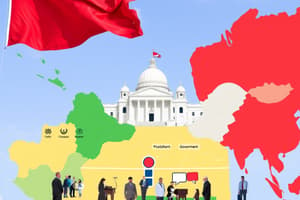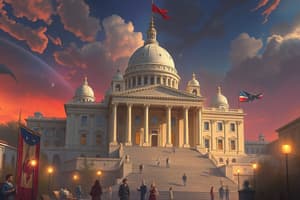Podcast
Questions and Answers
Which of the following best describes the concept of sovereignty?
Which of the following best describes the concept of sovereignty?
- The division of power between state and federal governments
- The economic control a nation has over its resources
- The ability of citizens to directly participate in government
- The right of a government to rule without external interference (correct)
In a direct democracy, citizens elect representatives to make decisions on their behalf.
In a direct democracy, citizens elect representatives to make decisions on their behalf.
False (B)
What is one key characteristic that distinguishes a totalitarian government from other forms of government?
What is one key characteristic that distinguishes a totalitarian government from other forms of government?
Total control over media/complete control over education/suppression of opposition
A government in which power is held by religious leaders who base law and policy on religious doctrines is called a ______.
A government in which power is held by religious leaders who base law and policy on religious doctrines is called a ______.
Match each form of government with its key characteristic:
Match each form of government with its key characteristic:
Which type of government is characterized by a centralized leader, use of propaganda, and suppression of individual freedoms?
Which type of government is characterized by a centralized leader, use of propaganda, and suppression of individual freedoms?
Colonialism primarily involves mutual benefit and resource sharing between two territories.
Colonialism primarily involves mutual benefit and resource sharing between two territories.
What is the purpose of the 'social contract' as it relates to government?
What is the purpose of the 'social contract' as it relates to government?
A document outlining the principles and laws of a government is called a ______.
A document outlining the principles and laws of a government is called a ______.
Match the following government types with their examples:
Match the following government types with their examples:
In a parliamentary democracy, how is the prime minister typically selected?
In a parliamentary democracy, how is the prime minister typically selected?
Direct democracy is easily implementable in large, modern countries.
Direct democracy is easily implementable in large, modern countries.
What is a 'coup' in the context of government?
What is a 'coup' in the context of government?
The economic system characterized by private ownership, free markets, and the pursuit of profit is known as ______.
The economic system characterized by private ownership, free markets, and the pursuit of profit is known as ______.
Match these economic systems with their characteristics:
Match these economic systems with their characteristics:
What was a primary weakness of the Articles of Confederation?
What was a primary weakness of the Articles of Confederation?
The Articles of Confederation established a strong central government.
The Articles of Confederation established a strong central government.
What event highlighted the weaknesses of the Articles of Confederation and led to calls for a stronger national government?
What event highlighted the weaknesses of the Articles of Confederation and led to calls for a stronger national government?
The ______ established a procedure for creating new states and outlawed slavery in the Northwest Territory.
The ______ established a procedure for creating new states and outlawed slavery in the Northwest Territory.
Match these historical influences with the element of the U.S. Constitution they inspired:
Match these historical influences with the element of the U.S. Constitution they inspired:
According to the provided text, what is the purpose of the preamble in a constitution?
According to the provided text, what is the purpose of the preamble in a constitution?
The US Constitution was created with the intention of mirroring the structure of the Articles of Confederation.
The US Constitution was created with the intention of mirroring the structure of the Articles of Confederation.
What is one key function a government is supposed to perform?
What is one key function a government is supposed to perform?
A government's responsibility to provide services such as schools, hospitals, and welfare programs falls under its duty to ______ the citizens.
A government's responsibility to provide services such as schools, hospitals, and welfare programs falls under its duty to ______ the citizens.
Match the key functions of government with their respective descriptions:
Match the key functions of government with their respective descriptions:
What is a key difference between a presidential democracy and a parliamentary democracy?
What is a key difference between a presidential democracy and a parliamentary democracy?
The United Kingdom is a pure monarchy where the monarch has absolute power.
The United Kingdom is a pure monarchy where the monarch has absolute power.
What is one potential drawback of a single-party state?
What is one potential drawback of a single-party state?
The form of government that believes that people within the nation they govern are the best is known as ______.
The form of government that believes that people within the nation they govern are the best is known as ______.
Match the economic system to the historical example:
Match the economic system to the historical example:
Flashcards
Sovereignty
Sovereignty
The right to exercise supreme authority over a region or group.
Monarchy
Monarchy
A single ruler with supreme authority.
Aristocracy
Aristocracy
Rule by rich nobles.
Oligarchy
Oligarchy
Signup and view all the flashcards
Direct Democracy
Direct Democracy
Signup and view all the flashcards
Representative Democracy
Representative Democracy
Signup and view all the flashcards
Dictatorship
Dictatorship
Signup and view all the flashcards
Totalitarianism
Totalitarianism
Signup and view all the flashcards
Theocracy
Theocracy
Signup and view all the flashcards
Colonialism
Colonialism
Signup and view all the flashcards
Socialism
Socialism
Signup and view all the flashcards
Social Contract
Social Contract
Signup and view all the flashcards
Natural Rights
Natural Rights
Signup and view all the flashcards
Autocracy
Autocracy
Signup and view all the flashcards
Anarchy
Anarchy
Signup and view all the flashcards
Constitution
Constitution
Signup and view all the flashcards
Preamble of a Constitution
Preamble of a Constitution
Signup and view all the flashcards
Presidential Democracy
Presidential Democracy
Signup and view all the flashcards
Parliamentary Democracy
Parliamentary Democracy
Signup and view all the flashcards
Single-Party State
Single-Party State
Signup and view all the flashcards
Dictatorships
Dictatorships
Signup and view all the flashcards
Theocracy
Theocracy
Signup and view all the flashcards
Aristocracy
Aristocracy
Signup and view all the flashcards
Capitalism
Capitalism
Signup and view all the flashcards
Communism
Communism
Signup and view all the flashcards
Socialism
Socialism
Signup and view all the flashcards
Mixed Economy
Mixed Economy
Signup and view all the flashcards
US Constitution
US Constitution
Signup and view all the flashcards
Articles of Confederation
Articles of Confederation
Signup and view all the flashcards
Shay’s Rebellion
Shay’s Rebellion
Signup and view all the flashcards
Study Notes
- Sovereignty is the right to wield supreme authority over a region, people, or oneself, encompassing the power to command and enforce.
Basic Governments
- Monarchy involves a single ruler with supreme authority, which can be absolute or partial, sharing power with another government body, like in England.
- Aristocracy is rule by rich nobles.
- Oligarchy is rule by a small group of wealthy, educated elites.
Democracy
- Direct Democracy entails every eligible individual directly voting on issues.
- Representative Democracy involves citizens voting for representatives.
- Democracies often adopt Presidential, Parliamentary, or mixed systems.
- Dictatorship is the rule by military leaders.
Totalitarianism
- Totalitarianism is based around a centralized leader employing propaganda.
- It suppresses opposition, exerts control over education and media.
- Maintained by a secret police force.
- Individual freedoms suppressed for citizens to conform to state goals.
- Inconsistent law enforcement creates fear.
- Theocracy sees power derived from a deity or religion and aligns state ideals with those of the people.
- Religious doctrines are enforced, leading to the suppression of other beliefs.
Colonialism
- Colonialism involves a leader exploiting another territory's resources for personal gain.
- Socialism connects politics and the economy, ideally prioritizing public good over profit.
Key Words
- Social Contract is an agreement where people give up some rights for safety, consenting to be governed.
- Natural Rights include life, liberty, and property.
- Autocracy is a form of government with one person holding total absolute power.
- Anarchy is the absence of government.
- Constitution is a document outlining the principles and fundamental laws of a government.
- Preamble of a Constitution states the reasons for its writing and establishes that government power comes from people.
- Most countries utilize some form of government, categorized into rule by one, few, or many.
Forms of Government
Presidential Democracy
- The people directly vote for the president.
- More attuned to public opinion than a parliament.
- Presidents have greater legitimacy due to public approval.
- Removing presidents from power is challenging.
- Originating in the USA, it lacks old historical examples.
Parliamentary Democracy
- Parliament makes laws and is elected by the people.
- Members of parliament elect a prime minister.
- Legislative and executive branches are merged.
- Parliament can remove the prime minister with a vote of no confidence.
- The English Parliament serves as a historical example.
Direct Democracy
- All citizens gather to vote, with each vote carrying equal weight.
- Impractical in the modern world due to large populations and time constraints.
- Switzerland approximates this model through citizen referendums on laws.
- Citizens can propose laws via the initiative process.
- Citizen participation may wane due to frequent voting.
- Limited forms exist in local town meetings.
- Athens provides a historical example.
Single-Party State
- The constitution allows only one party to govern.
- Power is concentrated among a small elite within the party.
- Elites nominate candidates and make decisions.
- Aims to avoid political infighting.
- Elites' views may diverge from public opinion, causing unrest.
- Dissenting voices are excluded.
- Most single-party states are socialist republics.
- Nazi Germany is a historical example.
Monarchy
- One of the oldest forms of government.
- Monarchal governments have existed for millennia.
- Efficient in decision-making.
- Loyalty to the ruling family unites the nation.
- Monarchs, such as kings, queens, sultans, emperors, or emirs, inherit power and usually rule for life.
- They often face legal restrictions.
- It still exists in the UK.
- Rome before becoming a Republic is a historical example.
Dictatorships
- Leaders seize power by force.
- There is centralization of power by a military officer or political leader.
- Pressure builds, leading to potential rebellion.
- Nazi Germany is a historical example.
Theocracy
- Political decisions align with religious values.
- Religious conflicts are common.
- Iran and Vatican City are current examples.
- The Iranian Caliphate is a historical example.
Aristocracy
- Originates from the Greek concept of "rule of the best."
- Society structured with nobles at the top, government in the middle, and commoners at the bottom.
- The French Nobility serves as a historical example.
Fascism
- It suppresses opposition/forces suppression of opposition.
- Believes that some people (specifically people in the nation the government is governing) is the best
- Fascism is characterized by militarism under a dictatorial leader.
- Fascist Italy is a historical example.
Mix of Governments
- The Roman Republic serves as a historical example.
Economics
Capitalism
- Focuses on the pursuit of profit.
- Operates on a free market system.
- Income is largely market-driven.
- There is private ownership of businesses and production.
- Leads to wealth concentration.
- The USA is a historical example.
Communism
- Aims for uniform wealth distribution.
- Aims to restricts monopolies.
- May disincentivize effort due to lack of advancement opportunities.
- The Soviet Union is a historical example.
Socialism
- Workers own the businesses.
- Aims to benefit everyone by controlling property for all.
- Aims to meet human needs directly.
- Government regulates pricing of goods and services.
- People depend on the government for needs.
- The People’s Republic of China in 1949 is a historical example.
Mixed Economy
- Emerges when government introduces state-owned entities into a free market or through taxes and tariffs.
- Can arise from socialist systems allowing free markets.
- Germany, India, China, and Japan are historical examples.
Articles of Confederation & Constitution
Origins of US Constitution
- 1776: US declared independence from Great Britain and Revolutionary War began
- From 1771-81 the US was governed by the Articles of Confederation.
- It made a weak federal government, states were given too much power, trading with each other but also taxing each other, and printing their own money
- 1787: Constitutional Convention was held to revise the articles.
- Everyone went rogue and just made a completely new one which is our current Constitution
- The convention was presided over by George Washington in Philadelphia, Pennsylvania.
US Constitution
- It is the supreme law.
- Frames the government (Right & Responsibilities)
- It outlines rights for citizens.
- It can be amended.
Articles of Confederation
- It was intended to avoid a strong central government to prevent replicating Great Britain's system.
- It was needed a government ASAP
- This lasted 10 years, as the first government attempt.
Historical Context
- First Government: Articles of Confederation (1781-1789)
- The Articles of Confederation lasted for only 10 years
- Government Type: A "firm league of friendship" among states
- Legislative Body: One-house Congress with each state having one vote
- Decision Making: Required 9 out of 13 votes for any decision
- No Executive or Judicial Branch: No president, no judiciary system
Limitations
- Limited powers of Congress:
- Could declare war, conduct foreign affairs, and make treaties
- Could NOT collect taxes; states were responsible for revenue
- Achieving policy changes was difficult due to the supermajority (9/13 states in agreement) requirement
Accomplishments
- War Victory: Successfully won the Revolutionary War (with caveats for slaves and Native Americans)
- Northwest Ordinance of 1787:
- Established a procedure for creating 5 new states (north of Ohio River)
- Acknowledged land claims of American Indians but was often ignored
- Outlawed slavery in new states
Major Issues
- Tax Collection: Inability to collect taxes led to massive debts for states and the national government
- Shays' Rebellion (1786-1787):
- A revolt led by Daniel Shays against foreclosures due to tax debts.
- Highlighted the weaknesses of the Articles of Confederation
- Reactions: mixed feelings among leaders
- Ex: Thomas Jefferson viewed rebellion positively, believing it was necessary for liberty.
- Conclusion: many elites felt that too much democratic liberty could threaten private property rights
- Articles of Confederation were deemed inadequate, leading to the creation of the U.S. Constitution to establish a stronger federal government
Historical Influences on Creating the Constitution
- Magna Carta
- English Bill of Rights: Determines rights of English Citizens, inspired US Bill of Rights
- John Locke’s Natural Rights (Life, Liberty, Pursuit of Happiness), Pursuit of Happiness changed to Property in US Constitution
- Montesquieu’s Separation of Powers (Judicial, Legislative, Executive)
- Jean-Jacques Rousseau’s Social Contract (People give up some rights for safety and protection of government)
- Shay’s Rebellion (1786-1787): Highlighted flaws of Articles of Confederation
Pros and Cons
- Pros:
- Established a constitutional government
- Let America successfully declare war
- Did not let the central government takeover/have too much power
- Cons
- Weak central government
What is a Government Supposed to Do
- Keep Order: Law enforcement to make sure people follow the laws
- Make Laws: Provides rules for the people to follow
- Protect the Country: Protects the people of the country and the territory from attack via military power
- Help the Citizens: Providing social services people need like schools, hospitals, etc.
Studying That Suits You
Use AI to generate personalized quizzes and flashcards to suit your learning preferences.




